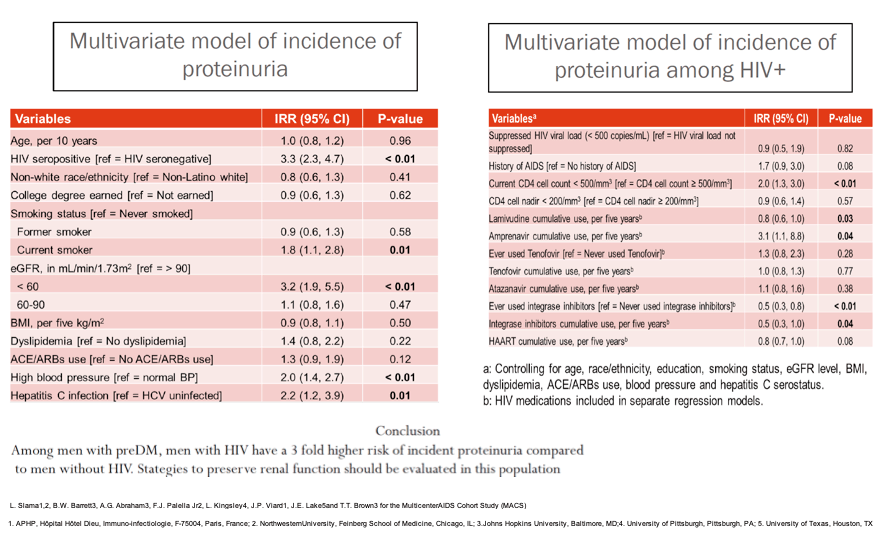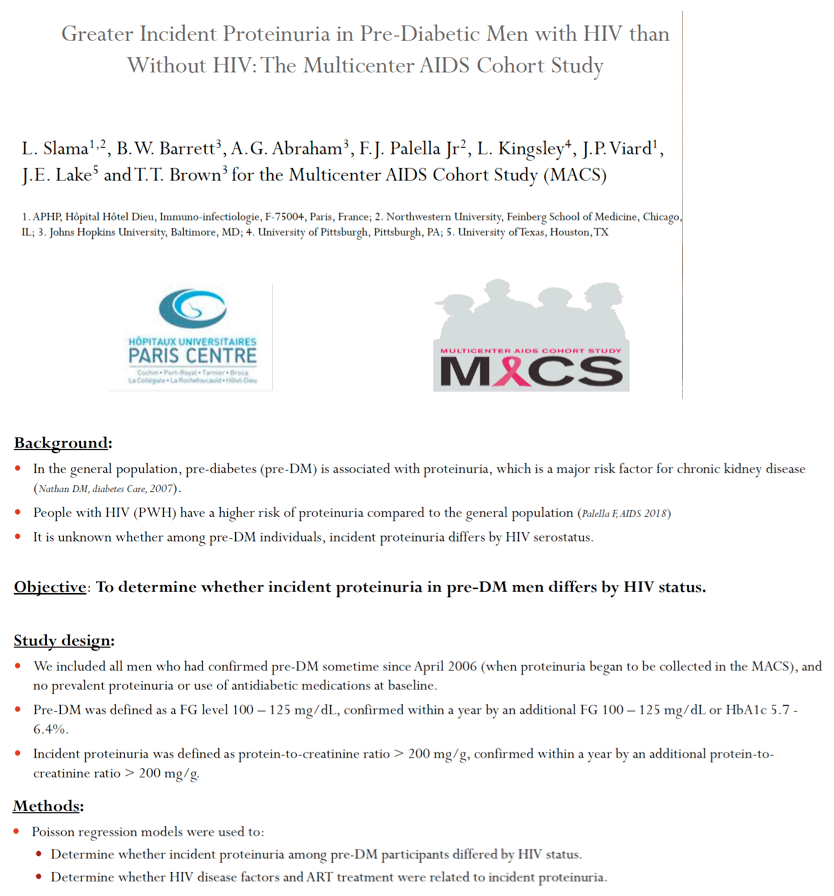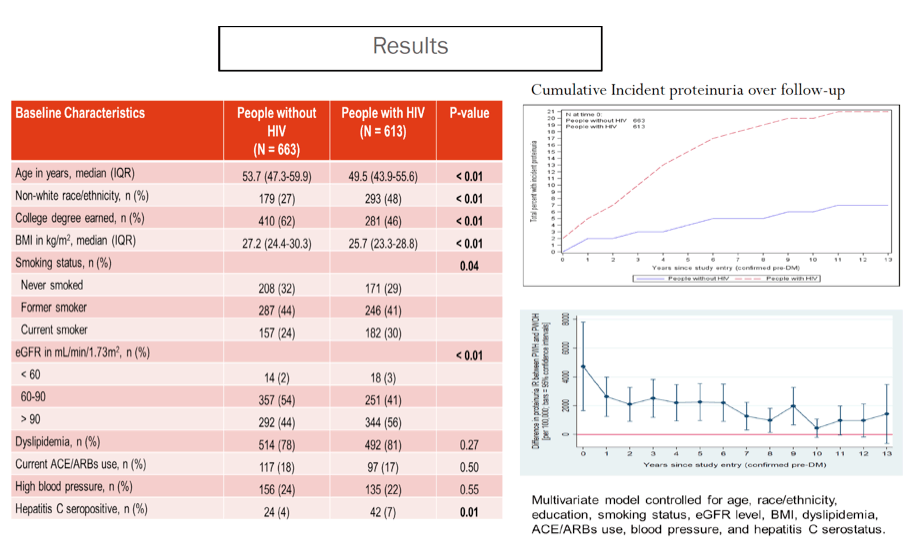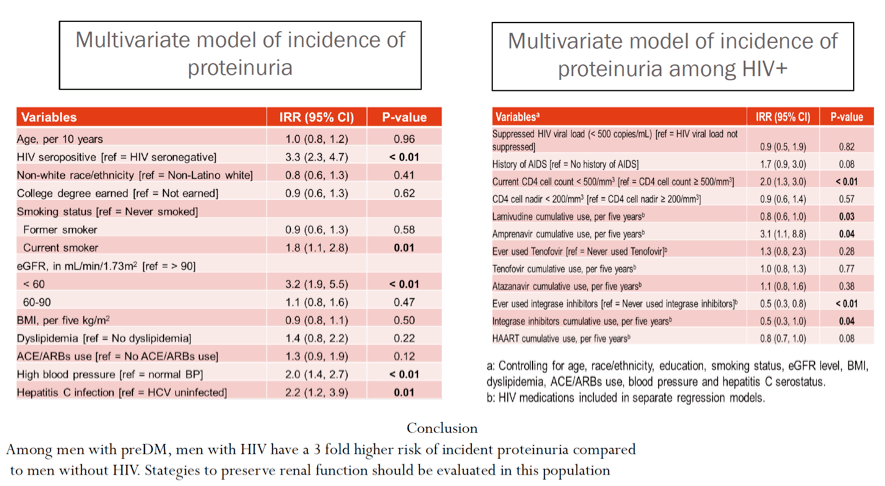 |
 |
 |
| |
Greater Incident Proteinuria in Pre-Diabetic Men with HIV than Without HIV: The Multicenter AIDS Cohort Study
|
| |
| |
Virtual 2020 International Workshop on Comorbidities & Adverse Drug Reactions in HIV
Reported by Jules Levin
L. Slama1,2, B.W. Barrett3, A.G. Abraham3, F.J. Palella Jr2, L. Kingsley4, J.P. Viard1, J.E. Lake5and T.T. Brown3 for the MulticenterAIDS Cohort Study (MACS)
1. APHP, Hôpital Hôtel Dieu, Immuno-infectiologie, F-75004, Paris, France; 2. NorthwesternUniversity, Feinberg School of Medicine, Chicago, IL; 3.Johns Hopkins University, Baltimore, MD;4. University of Pittsburgh, Pittsburgh, PA; 5. University of Texas, Houston, TX
What is proteinuria? Proteinuria is increased levels of protein in the urine. This condition can be a sign of kidney damage. Proteins - which help build muscle and bone, regulate the amount of fluid in blood, combat infection and repair tissue - should remain in the blood. Conditions that damage your kidneys can also make you have too much protein in your urine. The two most common are diabetes and high blood pressure. Other serious conditions that can cause proteinuria include: Immune disorders such as lupus. Protein gets into the urine if the kidneys aren’t working properly. Normally, glomeruli, which are tiny loops of capillaries (blood vessels) in the kidneys, filter waste products and excess water from the blood. Glomeruli pass these substances, but not larger proteins and blood cells, into the urine. If smaller proteins sneak through the glomeruli, tubules (long, thin, hollow tubes in the kidneys) recapture those proteins and keep them in the body. However, if the glomeruli or tubules are damaged, if there is a problem with the reabsorption process of the proteins, or if there is an excessive protein load, the proteins will flow into the urine. In many cases, proteinuria is caused by relatively benign (non-cancerous) or temporary medical conditions. These include dehydration, inflammation and low blood pressure. Intense exercise or activity, emotional stress, aspirin therapy and exposure to cold can also trigger proteinuria. In addition, a kidney stone in the urinary tract can cause proteinuria. Occasionally, proteinuria is an early indication of chronic kidney disease, a gradual loss of kidney function that may eventually require dialysis or a kidney transplant. Diabetes and high-blood pressure can damage kidneys and are the number-one and number-two causes of kidney disease. https://my.clevelandclinic.org/health/diseases/16428-proteinuria
In MACS
Between 2006 and 2019, of the 1,138 men with pre-DM (547 with HIV [MWH], 591 without HIV), 161 (14%) developed incident proteinuria (121 [22%] with HIV [MWH], 40 [7%] men without HIV) over a median of 10 years of follow-up (IQR: 5-12 years).
Conclusion
Among men with pre-DM [diabetes], men with HIV have a 3-fold higher risk of incident proteinuria compared
to men without HIV. Stategies to preserve renal function should be evaluated in this population.
• Pre-DM was defined as a FG level 100 -125 mg/dL, confirmed within a year by an additional FG 100 -125 mg/dL or HbA1c 5.7 -6.4%.
• Incident proteinuria was defined as protein-to-creatinine ratio > 200 mg/g, confirmed within a year by an additional protein-to-creatinine ratio > 200 mg/g.
In multivariate analysis tables just below you see in all MACS men current smoking in increased risk, so did eGFR <60 & high blood pressure and HCV infection. In HIV+ multivariate analysis found current CD4 <500 increased risk 2-fold, cumulative use of integrase inhibitors reduced risk.

L. Slama1,2, B.W. Barrett3, A.G. Abraham3, F.J. Palella Jr2, L. Kingsley4, J.P. Viard1, J.E. Lake5and T.T. Brown3 for the MulticenterAIDS Cohort Study (MACS)
1. APHP, Hôpital Hôtel Dieu, Immuno-infectiologie, F-75004, Paris, France; 2. NorthwesternUniversity, Feinberg School of Medicine, Chicago, IL; 3.Johns Hopkins University, Baltimore, MD;4. University of Pittsburgh, Pittsburgh, PA; 5. University of Texas, Houston, TX
abstract
Greater incident proteinuria in pre-diabetic men with HIV than without HIV: the Multicenter AIDS Cohort Study
L Slama1,3, B Barrett2, A Abraham2, FJ Palella Jr3, L Kingsley4, JP Viard1, JE Lake5, TT Brown2,
the Multicenter AIDS Cohort Study (MACS)
1APHP, Hotel Dieu Hospital, Infectious Diseases Unit F-75004, Université de Paris, France; 2Johns Hopkins University, Baltimore, MD, USA; 3Feinberg School, Northwestern University, Chicago, IL, USA; 4University of Pittsburgh, School of Medicine, Pittsburgh, PA, USA; 5University of Texas Health Science Center, Houston, TX USA
Background: In the general population, prediabetes (pre-DM) is associated with proteinuria, which is a major risk factor for chronic kidney disease. While people living with HIV (PLWH) have a higher risk of proteinuria compared with HIV-seronegative individu- als, it is unknown whether among those with pre-DM, incident proteinuria differs by HIV serostatus.
Methods: Urine protein and creatinine were measured at each semi-annual visit among men in the Multicenter AIDS Cohort Study (MACS; April 2006-present). Men with an observed case of confirmed pre-DM on or after April 2006 (baseline visit), no prevalent proteinuria at the baseline visit and no use of anti-diabetic medications at the baseline visit or during follow-up, were included in the analysis. Confirmed pre-DM was defined as fast- ing glucose (FG) of 100-125 mg/dl confirmed within a year by an additional FG 100-125 mg/dl or haemoglo- bin A1c 5.7-6.4%. Incident proteinuria was defined as protein-to-creatinine ratio >200 mg/g, confirmed at a subsequent visit within a year. We used Poisson regres- sion models to determine whether incident proteinuria in pre-DM participants differed by HIV serostatus, and among men with HIV, whether factors related to HIV treatment and disease severity were related to incident proteinuria.
Results: Between 2006 and 2019, of the 1,138 men with pre-DM (547 with HIV [MWH], 591 without HIV), 161 (14%) developed incident proteinuria (121 [22%] with HIV [MWH], 40 [7%] men without HIV) over a median of 10 years of follow-up (IQR: 5-12 years). After adjustment for age, race/ethnicity, edu- cation, smoking status, hepatitis C virus serostatus, BMI, dyslipidaemia, hypertension and eGFR ever <60 ml/min/1.73 m2, MWH had an incidence of proteinuria that was 4.2 times (95% CI: 2.8, 6.4) greater than that of men without HIV (P<0.01). Among MWH, history of AIDS (P=0.06) and current CD4 cell count <500/mm3 (P<0.01) were both associated incident proteinuria in
multivariable models, whereas HIV viraemia (>500 copies/ml) and cumulative exposure to tenofovir, stavudine or protease inhibitors showed no association.
Conclusions: Among men with pre-DM, men with HIV have a fourfold higher risk of incident proteinuria com- pared with men without HIV. Strategies to preserve renal function should be evaluated in this population.


On the left side of the slide , you’ll see the baseline caracteristics of the 1276 men with pre DM (613 with HIV and 663 without HIV) included between 2006 and 2019
HIV infected men were younger, more likely to be non white, have a lower BMI and HCV co infected
On the right side we observed that 20% of HIV+ and 6 % of HIV negative developped incident proteinuria over a median of 10 years of follow up
The second graph below displays, at each point in time, the difference in the incidence rate of proteinuria between people with HIV and people without HIV, per 100,000 person-years controlled for all the variables listed below. For example, at 1 year since study entry, people with HIV had an incidence rate of proteinuria that was ∼2,500 cases/100,000 person-years greater than the incidence rate of proteinuria for people without HIV. The vertical bars are 95% CIs of the difference estimate. So here we can see that PWH consistently have a significantly higher IR of proteinuria than PWOH up to about 10 years after baseline.

|
| |
|
 |
 |
|
|